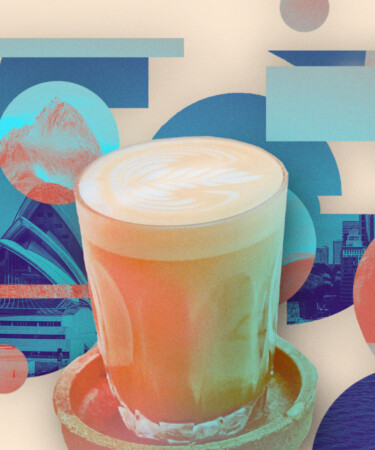When a beverage is put on the menu at Starbucks, it reaches a certain level of ubiquity. Hence, when the chain added the flat white to its U.S. menu in 2015, the drink rose in popularity so rapidly that it is now the second most ordered beverage at coffee shops in America. However, not even a decade ago, the flat white was a beverage completely foreign to the U.S. market — so how did this hot drink get into our hands?
The flat white actually has quite a contentious history. What might sound like an innocent combination of espresso and frothy steamed milk has actually been used as a weapon in an ongoing rivalry between Australia and New Zealand. The two nations have long battled over credit for various culinary staples such as the beloved pavlova, and now, the flat white. VinePair chatted with Joshua Evans, owner of Banter, an Australian cafe in New York City, to learn more.
First of all, what exactly is a flat white, and how is it different from your typical latte? Evans says that “the major difference is the amount of milk and foam.” Lattes have a larger proportion of steamed milk and a thick layer of foam, whereas flat whites have a signature thin layer of steamed milk that is made to be like a microfoam with small bubbles, imparting a velvety texture. At Banter, all espresso-based drinks are made with two shots, but in most cases, a latte contains one shot of espresso whereas a flat white is typically made with two. Evans distinguishes the drinks at Banter by serving lattes in eight-ounce glasses and flat whites in six-ounce ceramic mugs.
In terms of where the drink comes from, Evans credits Australia’s pervasive coffee culture. It is believed that an influx of Italian immigrants brought their appreciation for espresso and cafes to Australia after World War II, and it took off from there. “I’m from Melbourne, which is probably the most well-known [city] for its cafes in Australia,” says Evans. “There is an artisanal coffee shop on every block; it is really ingrained in our culture.”
According to Evans, the flat white “has been around in Australia since the 1980s, where it was introduced as a balance between an intense espresso and a milky latte.” While most sources agree that the flat white originated in either Sydney or Melbourne, there are claims that the modern form of the beverage was perfected in Wellington, New Zealand in the 1990s. No matter which antipodean nation truly invented this beloved beverage, it is clear that its proliferation can be credited to the international expansion of Australian cafes.
The first wave of the Australian cafe takeover was in the U.K. One of the first Aussie-inspired coffee shops to pop up in London, aptly named Flat White, opened in 2005. It was swiftly followed by similar spots like Daisy Green, Kaffeine, and Granger and Co., all featuring the signature beverage from Down Under.
The second stop of Australia’s international tour was the U.S., with the powerhouse coffee chain Bluestone Lane landing in New York in 2013. Other NYC cafes slinging flat whites, avo smash, and sunny feel-good vibes, including Little Collins, Two Hands, and Hutch + Waldo, quickly followed suit.
After seeing the success of Australian cafes in New York, Evans — who was working as a barista in Melbourne at the time — saw an opportunity to start his own and opened Banter on Sullivan Street in February 2017. Now a wildly popular brunch destination, Banter has expanded with a second location and even launched a new Australian concept called Sonnyboy in 2019. Evans said when he first moved to New York about eight years ago, flat whites could only be found on about 30 percent of coffee shop menus, but now, you can get one at just about any cafe.
When asked about the conflict between Australia and New Zealand, Evans laughs and says, “I’m not going to jump in and claim anything, but the battle continues.”
